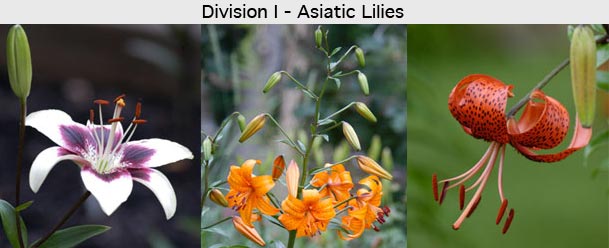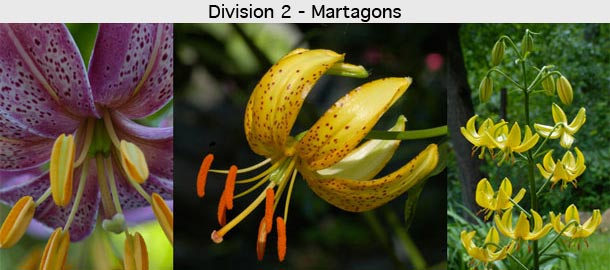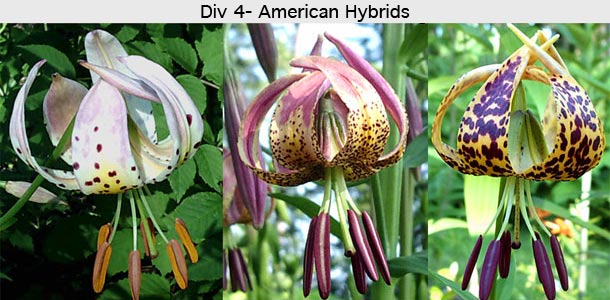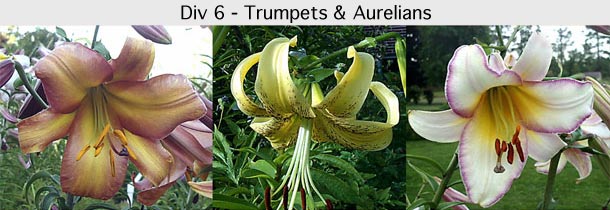But which lilies to choose?
The catalogs, with their pages and pages of breathtaking pictures and tempting descriptions, are a marvelous confusion of exciting possibilities. We can’t grow them all! Some are easier than others and some bloom earlier or later. Some need full sun while others prefer a bit of shade.
We can’t tell you about each one, but lilies are classified into several broad categories according to various traits that they share in common. So let’s look at them according to the classification system into which they have been placed. We can’t tell you about each one, but there is a Horticultural Classification that arranges the various types of lilies into broad groups according to parentage, further classified by flower shape.
Asiatic Hybrids – Horticultural Division 1
The asiatic hybrids are among the earliest to bloom, and also the easiest of lilies to grow! You can plant these lilies almost anywhere…especially in brightest sunshine with lots of gay garden plants for company. They have the broadest color range of any division, including whites, pinks, plums, yellows, oranges, and reds. Their flowers can be upfacing, outfacing, or pendant, and generally are not scented.
Technically speaking, Division 1 lilies are hybrids derived from such species as L. tigrinum, L. cernuum, L. davidii, L. maximowiczii, L.x macultum, L. x hollandicum, L amabile, L. pumilum, L. concolor, and L. bulbiferum.
Martagon Hybrids – Horticultural Division 2
Along with the earliest of the asiatics, blooms another entirely different group called the martagons, or martagons hansonii hybrids. These are tall lilies with many little down-facing flowers and whorled leaves. Martagons appreciate some shade, and are quite decorative in the woodland garden. Though it might take them a year to adjust to a new garden, once established, the martagons will thrive for years. Yellow, white, pink, lavender, light orange, deep dark red are the colors most often seen, often with whimsical freckles and spots. Martagons do not typically grow well in hot, humid climates.
Division 2 lilies include hybrids derived from such species as L Martagon, L hansonii, L medeoloides, and L tsingtauense.
Candidum Hybrids – Horticultural Division 3
Division 3 includes hybrids derived from such as L candidum, L chalcedonicum, L monadelphum, and other related European species, but excluding L Martagon.This division includes very few entries, and they are not easily found in commerce.
American Hybrids – Horticultural Division 4
There are many lilies native to North America. If you live on the West Coast, you perhaps are familiar with L. columbianum, and L. pardalinum. There are other lovely and different ones too. In the east there are L. canadense, L. superbum and L. philadelphicum. In the middle states there is L. michiganense, and, in the south, L. grayi, L. michauxii, L. catesbaei and L. iridollae. Just because these lilies grow wild does not mean they are easy to grow in your garden. You might try them in time. The bulbs which are made up of little jointed scales are unique while the blooms are like bouncy, bright butterflies on swinging curved pedicels.
Bulbs of this group when planted 5 inches deep in cool, light soil, can make huge clumps if left undisturbed. They show off best in dappled shade on the edge of woodlands with ferns and other native plants. American Hybrids bloom about the end of June and early July although if they are planted south of Philadelphia they will bloom in late May to mid-June.
Division 4 includes hybrids derived from North American species, such as L pardalinum, L humboldtii, L kelloggii, and L parryii.
Longiflorum Hybrids – Horticultural Division 5
This division includes hybrids derived from L longiflorum and L formosanum. These hybrids are generally elegant white trumpets, easily raised from seed, but not particularly hardy in the garden.
Trumpet and Aurelian Hybrids – Horticultural Division 6
To some people no lily is a real lily unless it is a trumpet! Who can deny that a trumpet lily is like no other plant in the garden — tall, stately, serene and magnificent, raising its huge waxy flowers full of fragrance above lesser insignificant companion plants. Happily, trumpet hybrids are easy to grow especially the type called Aurelians with their inheritance of hardiness from the rugged species, L. henryi. The old type Regal lilies with their wheel-shaped inflorescence are still grown but have been superseded by newer strains with tall pyramids of bloom colored not only pure glistening white, but bright gold, yellow, chartreuse, pink, plum, and apricot, with some having backs of brown, purple or iridescent green! Some of the trumpets are pendant like bells on a pagoda; others flare widely in a shallow bowl shape; and still others are upfacing.
Trumpet lilies gradually blend into Aurelians as the season progresses. Trumpets and Aurelians are classified in the same division. L. henryi is a tightly recurved lily, and when crossed with the trumpets, it is responsible for the flaring of the petals, the wide bowls, sunbursts, and stars.
These Aurelian sunbursts and flares typically bloom later than the trumpets. They favor their L. henryi parent more so and have taller, often more willowy stems. Sometimes secondary and/or tertiary buds are a feature of these late bloomers giving them a long glorious season.
Trumpets and Aurelians are all important lilies as prima donnas of the July and August garden. Feature them amongst drifts of summery annuals combined with phlox and meadow rue, delphinium and platycodon. Plant in front of climbing roses and against evergreens or next to the patio. These are the lilies that will give your garden individuality and distinction. They may need a bit of staking lest the huge flower heads break in a sudden summer storm; they may benefit from mulching in colder climates; and some protection from spring frosts as the shoots emerge is important but these little services are amply repaid by the long season of spectacular, fragrant bloom. Trumpets and Aurelians are very easily grown from seed too. Choose some of the very best clones and strains and try your hand at hybridizing.
Division 6 includes hybrids derived from L luecanthum, L regale, L sargentiae, L sulphureum, and L henryi.
Oriental Hybrids – Horticultural Division 7
Lilies of this exotic group are not among the easiest to grow. But you will try them we know! Like a fairy spell, one glimpse of these enchanting flowers will cause you to lose all sense of practicality. Just to possess one and to grow such a magnificent plant in your own garden is the unswerving desire of many lily lovers.
These L. auratum and L. speciosum hybrids are typically stronger and more resistant than their species parents, and are often more spectacular. L. speciosum, the old Rubrum lily, is reasonably dependable and L. auratum var. platyphyllum, the broad-leaved variety of the Gold Band Lily is more vigorous than its cousins; but for sheer bewitching beauty, please try some of the newer strains. Give them plenty of water, provide humus rich soil that is acidic, and mulch for a cool root run.
Division 7 includes hybrids derived from L auratum, L speciosum, L nobilissimum, L rubellum, L alexandrae, and L japonicum.
Interdivisional Hybrids – Horticultural Division 8
In recent years, thanks to new technology and scientific initiative, a number of startling interspecific hybrids have been attained through the use of cut-style pollinations, embryo rescue and other methodologies.
LA hybrids are the result of crossing L. longiflorum (the Easter lily) with Asiatic varieties. Most of such crosses on the market have larger flowers, a very slight fragrance and hardiness.
The OT hybrids involve crossing Oriental lilies with Trumpet/Aurelian lilies. OT hybrids can be outstandingly beautiful, robust and durable, such as ‘Black Beauty’ through to the currently popular ‘Leslie Woodriff,’ ‘Scheherazade’ and ‘Starburst Sensation.’
OA hybrids are derived from crossing Orientals with Asiatics. New and exciting lily characteristics are the promise of such lines. Newer lines involving crossing these new hybrids (e.g. OTLA) mean that the future will bring even more variety, beauty, health, hardiness and disease resistance.
Species – Horticultural Division 9
Species lilies are wild lilies. Native lilies occur in North America, Europe, and especially Asia (Japan, China, Burma, and India). It is from these wild lilies that breeders have created their magnificent hybrids for our gardens. Species lilies oftentimes possess a delicate charm that appeals to many people, and many of the species make fine garden plants, while others are a real challenge to grow.




